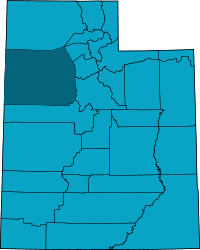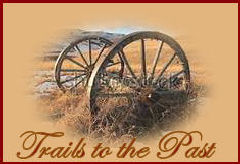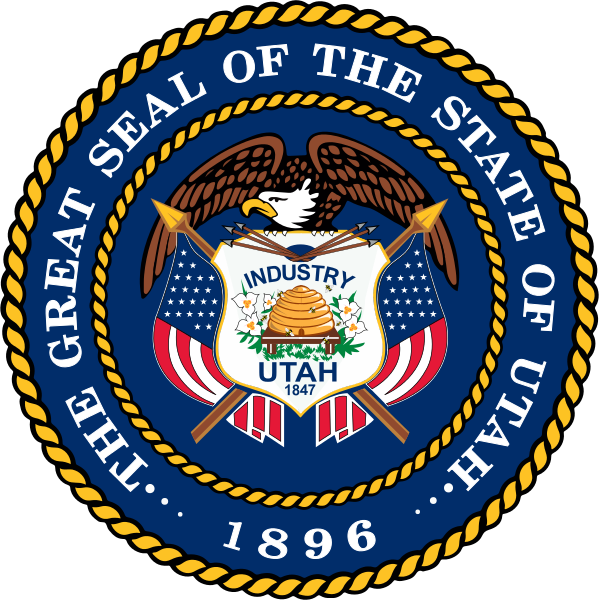Trails to the Past of Utah is requesting any genealogy materials that you may have such as Obituaries, News Clippings, Wills, Deaths, Births, and Marriages, You do not need the certificates, but only the source of the information. If you should happen to have any of these items, please email them to Marie Miller, the State of Utah Administrator. Thank you.
Its county seat and largest city is Tooele. Evidence of several indigenous Native American groups has been found in Tooele County, but only the western Shoshone-speaking Goshute tribe claim the desolate lands as their ancestral home. The Goshute's traditional territory includes most of modern Tooele County.
In 1849, the first whites, Latter-day Saints established permanent settlement in the area. Building a sawmill, the settlement was called "E.T. City" after LDS leader E.T. Benson. The territorial legislature first designated Tooele County-initially called "Tuilla"-in January 1850 with significantly different boundaries. It is speculated that the name derives from a Native American chief, but controversy exists about whether such chief lived. Alternate explanations hypothesize that the name comes from "tu-wanda", the Goshute word for "bear", or from "tule", a Spanish word of Aztec origins meaning "bulrush". Tooele was one of the six original counties in Deseret, which would become Utah Territory.By 1852, Grantsville, Batesville, and Pine Canyon (later named Lincoln) were settled.In 1855 the town of Richville was designated county seat, but it soon became clear that Tooele was much larger. In 1861 the territorial legislature allowed the county to select a new seat, and Tooele was selected.
Tension with native Goshutes plagued settlement in early Tooele County. In response to cattle thefts, a contingent of at least 50 men pursued Goshutes and attacked their camp in 1851, killing nine. The settlers suffered no casualties. Similar attacks occurred throughout the 1850s with natives typically being on the losing side. In 1859 Robert B. Jarvis, a U.S. Bureau of Indian Affairs representative, convinced some of the nomadic bands to congregate at a farm reservation called Deep Creek. The results looked promising, but Jarvis resigned in 1860 and support for the project disappeared, causing the farm to be abandoned. Jarvis' replacement, Benjamin Davies, noted the Goshutes had lost faith in the federal government, and recommended limiting further encroachments on Goshute land, but his suggestions were largely ignored.
Twenty-two overland stagecoach outposts were built in Goshute territory, often on the sites of rare natural springs. Goshute attacks on mail outposts escalated in 1860, resulting in dozens of deaths in alternating waves of raids. At the outbreak of the American Civil War, federal troops left the area leaving defense in the hands of the Nauvoo Legion until General Patrick E. Connor arrived in Salt Lake City from California in 1862.Connor acted ruthlessly toward the natives. He killed over 300 Shoshone in Southern Idaho in 1863. Connor's men attacked Native American camps, sometimes indiscriminately, but through 1863 stage coach companies had lost 16 men and over 150 horses to depredations. A peace treaty was signed in 1863 which included an annuity of goods and US $1000 in compensation of killed game in exchange for an end to the hostilities, and use of routes through the natives' territories. The treaty did not cede Goshute control of land, but a follow-up agreement made in June 1865 did.General Connor, who was anti-Mormon, also encouraged his troops to prospect for minerals. Connor believed that mining would bring non-Mormons to Utah Territory. After his men discovered gold, silver, lead, and zinc deposits in Tooele County in 1864 he was proven right. The Rush Valley Mining District was established by soldiers in the western Oquirrh Mountains and more than 100 claims were staked in the first year. Two new mining towns, Ophir and Lewiston ballooned to over 6000 people each in the 1870s, exceeding the population of Tooele and all the other Mormon settlements in the area.
From 1874 to 1879, non-Mormon politicians from the Liberal Party of Utah gained control of Tooele County, the first time any non-Mormons had success in Utah politics. Whimsically, they called the county the Republic of Tooele.The 1874 election marked the first success of the anti-Mormon Liberal Party, which was organized in 1870. The party viewed the large non-Mormon mining population in the county as a natural environment for electoral success and campaigned fiercely in Tooele's mining districts leading up to the June 1874 election. The non-Mormon appointed governor of Utah Territory, George L. Woods, personally campaigned for the Liberals in Tooele County.
The incumbent Mormon People's Party observed several Tooele polling places on election day and lodged complaints of fraud after the Liberal Party triumphed by about 300 votes out of 2200. The People's Party alleged that Liberal Party supporters had voted more than once, that many of them had not been residents for the required six months, and that they were not taxpayers-according to territorial law, only taxpayers could vote in elections. The People's Party called attention to the fact that about 2200 votes were cast in the election although only 1500 Tooele County property taxpayers were on record. Incumbents refused to yield control of the Tooele County recorder's office and the Tooele County Courthouse because of the alleged fraud.
Governor Woods predictably dismissed the complaints and certified the Liberal victory. Third District Court Judge James B. McKean ruled that no evidence showing illegal activity had been presented. McKean construed poll tax as within the meaning of being a taxpayer. Since no evidence was provided that there were over 300 carpetbaggers or repeat votes in the election, McKean sustained the tally and authorized deputy U.S. Marshals install the Liberal candidates.
The recorder's office was seized when it was momentarily abandoned, but a contingent of People's Party supporters and incumbents held the county courthouse night and day. The marshals and Liberal Party candidates, outnumbered, attempted to negotiate with the armed and barricaded Mormons. Aware that any show of aggression could spark a battle, the parties were nonetheless unable to come to an agreement to hand over power.
Judge McKean issued an even more strongly worded injunction, and Brigham Young advised his followers that they had an obligation to obey the federal courts. The county courthouse was abandoned, thus beginning about five years of Liberal Party rule. However, the Utah territorial legislature, which had the last say on the qualifications of its members, refused to seat the Liberal Party representative from Tooele County.The Liberals won an unopposed 1876 election.
In 1876, the territorial legislature passed bills requiring voter registration and requiring women's suffrage for local elections-women had been voting in territorial elections since 1870. The Liberal Party, typically supported by male miners casually interested in politics, opposed both measures. In 1878 the Liberal majority in Tooele County disappeared, and the People's Party regained control in 1879 after more than six months of Liberal procedural delays.
The Republic of Tooele era was characterized by subsequent politicians as one of excessive spending. The county was left with about $16,000 debt, significantly more than it started with.
Cities and Towns
Grantsville, incorporated in 1867
Ophir
Rush Valley
Stockton
Tooele, incorporated in 1853
Vernon
Wendover, incorporated in 1950 |

|
| |
|
On Line Data
|
|

|
Adjacent Counties
Box Elder County, Utah (north)
Weber County, Utah (northeast)
Davis County, Utah (east)
Salt Lake County, Utah (east)
Utah County, Utah (east)
Juab County, Utah (south)
White Pine County, Nevada (southwest)
Elko County, Nevada (west)



